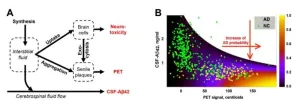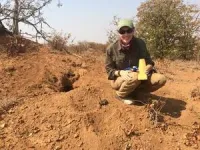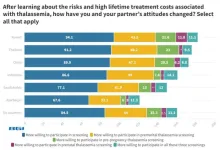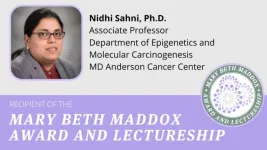(Press-News.org) Despite affecting millions worldwide, Alzheimer's disease (AD) has long lacked effective treatments due to a fundamental inadequacy of our understanding of its etiology and pathogenesis. The absence of an integrative theory connecting the molecular origins of AD with disturbances at the organelle and cell levels, changes in relevant biomarkers, and population-level prevalence has hindered progress. Even though most scientists only hope that an integrative theory of AD will emerge soon, scientists from Zarbio and Georgia State University discovered sufficient data to formulate a framework for such a theory.
The molecular and cellular levels of this framework were initially summarized as the Amyloid Degradation Toxicity Hypothesis. Diverging from previous amyloid-centric theories, it posits that beta-amyloid peptide (Aβ) enters cells through endocytosis and is transported to lysosomes for degradation. However, instead of complete degradation, some Aβ fragments form pores in lysosomal membranes, leading to cell death as lysosomal proteases leak into the cytoplasm. The Amyloid Degradation Toxicity Hypothesis was recently extended to the population level in a scientific article titled "Towards the Integrative Theory of Alzheimer's Disease: Linking Molecular Mechanisms of Neurotoxicity, Beta-Amyloid Biomarkers, and Diagnosis." Authored by Yaroslav Molkov (GSU), Maria Zaretskaia, and Dmitry Zaretsky (Zarbio), the article was published in the Current Alzheimer Research journal.
One of the central paradoxes in Alzheimer's research is the strong correlation between AD diagnosis and the high density of non-toxic amyloid deposits (senile plaques) in the brain. The density can be measured by positron emission tomography (PET) and is an established AD biomarker. The second paradox involves lower concentrations of toxic soluble Aβ42 in the cerebrospinal fluid (CSF-Aβ42, another AD biomarker) in AD patients. Any viable hypothesis must explain these phenomena, and the manuscript does that.
According to the Amyloid Degradation Toxicity Hypothesis, cytotoxicity depends on the cellular uptake of soluble Aβ rather than the presence of amyloid aggregates. The accumulation of cellular damage defines the probability of an AD diagnosis. Also, the authors argue that spontaneous extracellular seed formation is improbable due to low Aβ concentration. In contrast, endocytosed Aβ is concentrated and stored intra-lysosomally, where it forms aggregation seeds. Aggregation seeds cannot be digested and, when exocytosed, grow into senile plaques. Therefore, to become aggregated, Aβ needs to be taken by brain cells first. The dependence of both Aβ toxicity and aggregation on the same process – cellular uptake of Aβ – resolves both paradoxes.
To test the validity of their conclusions, the researchers used the Alzheimer's Disease Neuroimaging Initiative (ADNI) database, the most comprehensive dataset on amyloid biomarkers. The model that formalizes the described concept reproduced clinical data at a 95% confidence level, providing strong support for the Amyloid Degradation Toxicity Hypothesis. Notably, natural limitations on rates of cellular amyloid uptake explain the characteristic distribution of two amyloid biomarkers in the population.
“To the best of our knowledge, it is the first mechanistic explanation of why amyloid biomarkers are informative in AD diagnostics, even though they are indirectly related to the pathophysiology of the disease. Importantly, the Amyloid Degradation Toxicity Hypothesis not only addresses long-standing paradoxes but also provides a comprehensive framework that allows us to propose new pathophysiology-relevant biomarkers to diagnose or even predict AD,” says Dmitry Zaretsky, the Founder of Zarbio. “Our next goal is to use the proposed framework to identify pharmacological targets that are scientifically relevant to AD pathophysiology.”
The groundbreaking findings from Zarbio and Georgia State University offer a promising step forward in understanding AD. They could pave the way for more effective treatments and preventive measures for this debilitating disease.
Read the Full-text article here: https://www.eurekaselect.com/article/133880
END
Breaking the mold: Zarbio and Georgia State scientists unveil game-changing theory on Alzheimer's disease
The article by Dr. Dmitry Zaretsky and colleagues is published in Current Alzheimer Research. 2023
2023-12-18
ELSE PRESS RELEASES FROM THIS DATE:
Scientists collect aardvark poop to understand how the species is impacted by climate in Africa
2023-12-18
CORVALLIS, Ore. – In a first-of-its-kind study of aardvarks, Oregon State University researchers spent months in sub-Saharan Africa collecting poop from the animal and concluded that aridification of the landscape is isolating them, which they say could have implications for their long-term survival.
“Everyone had heard of aardvarks and they are considered very ecologically important but there has been little study of them,” said Clint Epps, a wildlife biologist at Oregon State. “We wanted to see if we could collect enough data to begin to understand them.”
In ...
Thalassemia screening in Thailand: Medical Sciences Dean advocates for elevated trust
2023-12-18
- Insights from Professor Sakorn Pornprasert, Dean, Faculty of Associated Medical Sciences at Chiang Mai University, on raising thalassemia awareness in Thailand.
Thalassemia, a genetic disorder affecting hemoglobin production, poses a significant public health challenge in Thailand, with a high prevalence and substantial healthcare costs. According to Thailand's Ministry of Public Health, approximately 18-24 million or 30-40 percent of the Thai population carries the thalassemia gene.
Professor Sakorn Pornprasert, Dean, Faculty of Associated Medical Sciences, Chiang Mai University, shared his views on BGI Genomics Global 2023 State of Thalassemia Awareness ...
Lung nodule program provides benefits patients ineligible for lung cancer screening
2023-12-18
(Denver—December 18, 2023) – Adopting a lung nodule program (LNP) may increase the detection of early lung cancer for patients who are not eligible for lung cancer screening under existing age eligibility criteria, according to a study published in the Journal of Thoracic Oncology, an official journal of the International Association for the Study of Lung Cancer.
LNPs are established to follow up on lung nodules that are frequently identified during routine imaging for reasons other than suspected lung cancer or lung cancer screening.
The research was conducted by a team led by Dr. Raymond U. Osarogiagbon, MBBS, FACP, chief scientist ...
Multi-site study reveals addressable socioeconomic barriers to prenatal diagnosis of congenital heart defects
2023-12-18
Prenatal diagnosis of congenital heart defects – the most common birth defects in the United States – is associated with improved outcomes. Despite its importance, however, overall prevalence of prenatal diagnosis is low (12-50 percent). A recent multi-center study surveyed caretakers of infants who received congenital heart surgery in the Chicago area and found that social determinants or influencers of health constitute significant barriers to prenatal diagnosis from the patients’ perspective.
In ...
Wildfires increasing across eastern U.S., new study reveals
2023-12-18
In a new analysis of data spanning more than three decades in the eastern United States, a team of scientists found a concerning trend – an increasing number of wildfires across a large swath of America.
“It’s a serious issue that people aren’t paying enough attention to: We have a rising incidence of wildfires across several regions of the U.S., not only in the West,” said Victoria Donovan, lead author of the study and an assistant professor of forest management at the UF/IFAS ...
Nurse aide turnover linked to scheduling decisions
2023-12-18
Long-term care facilities that scheduled part-time Certified Nursing Assistants (CNAs) with more hours and more consistently with the same co-workers had reduced turnover, according to research led by Washington State University. The findings could help address staffing challenges that affect millions of patients at long-term care facilities nationwide.
Using a model based on real scheduling data of thousands of nurse aides, the researchers estimated that a one-hour increase in CNAs’ weekly hours worked could reduce turnover by 1.9%. Also, the analysis found that by scheduling ...
TAMEST names Nidhi Sahni, Ph.D., as the Recipient of the 2024 Mary Beth Maddox Award & Lectureship
2023-12-18
AUSTIN/HOUSTON – TAMEST (Texas Academy of Medicine, Engineering, Science and Technology) has announced Nidhi Sahni, Ph.D., The University of Texas MD Anderson Cancer Center, as the recipient of the 2024 Mary Beth Maddox Award and Lectureship in cancer research. She was chosen for her role in identifying novel biomarkers and drug targets, which are expected to have a significant impact on cancer by translating into more effective prognosis and therapy for the disease.
The Mary Beth Maddox Award and Lectureship recognizes women scientists in Texas bringing new ideas and innovations to the fight ...
Do genes that code athletic heart enlargement carry a risk of future heart problems?
2023-12-18
A new landmark study involving 281 elite athletes from Australia and Belgium has revealed one in six have measures that would normally suggest reduced heart function.
Genetic analysis published in Circulation conducted by scientists in Australia and Belgium revealed those athletes also had an enrichment of genes associated with heart muscle disease.
Thus, a genetic predisposition may be ‘stressed’ by exercise to cause profound heart changes. The international collaboration will continue to monitor the athletes over the long-term to determine the consequences on their heart health.
Associate Professor Andre la Gerche, who heads the HEART Laboratory that is jointly ...
ASU research reveals regions in U.S. where heat adaptation and mitigation efforts can most benefit future populations
2023-12-18
Tempe, Ariz., December 18, 2023 – Extreme heat waves, once considered rare, are now frequent and severe in cities due to climate change. Phoenix faced such a brutal heat wave in July of 2023 when it endured 31 consecutive days of high temperatures of at least 110 F. The severity of the heat wave triggered a state of emergency. In June of 2021, the town of Lytton, B.C., Canada, hit a blistering 121 F, leading to a fire that burnt most of the village. This pattern repeated in Europe in 2022, where heat caused fatal illnesses, wildfires and damaged infrastructure, highlighting ...
Global inventory of sound production brings us one step closer to understanding aquatic ecosystems
2023-12-18
Scientists looking to uncover the mysteries of the underwater world have more valuable information at their fingertips thanks to an international team that has produced an inventory of species confirmed or expected to produce sound underwater.
Led by Audrey Looby from the University of Florida Department of Fisheries and Aquatic Sciences, the Global Library of Underwater Biological Sounds working group collaborated with the World Register of Marine Species to document 729 aquatic mammals, other tetrapods, fishes, and invertebrates that produce active or passive sounds. In addition, the inventory includes another 21,911 species that ...
LAST 30 PRESS RELEASES:
NTIDE: Disability employment holds steady after data hiatus
Social lives of viruses affect antiviral resistance
Dose of psilocybin, dash of rabies point to treatment for depression
Helping health care providers navigate social, political, and legal barriers to patient care
Barrow Neurological Institute, University of Calgary study urges “major change” to migraine treatment in Emergency Departments
Using smartphones to improve disaster search and rescue
Robust new photocatalyst paves the way for cleaner hydrogen peroxide production and greener chemical manufacturing
Ultrafast material captures toxic PFAS at record speed and capacity
Plant phenolic acids supercharge old antibiotics against multidrug resistant E. coli
UNC-Chapel Hill study shows AI can dramatically speed up digitizing natural history collections
OYE Therapeutics closes $5M convertible note round, advancing toward clinical development
Membrane ‘neighborhood’ helps transporter protein regulate cell signaling
Naval aviator turned NPS doctoral student earns national recognition for applied quantum research
Astronomers watch stars explode in real time through new images
Carbon-negative building material developed at Worcester Polytechnic Institute published in matter
Free radicals caught in the act with slow spectroscopy
New research highlights Syntax Bio’s platform for simple yet powerful programming of human stem cells
Researchers from the HSE University investigated reading in adolescents
Penn Nursing study: Virtual nursing programs in hospitals fall short of expectations
Although public overwhelmingly supports hepatitis B vaccine for a newborn, partisan differences exist
DFW backs UTA research to bolster flood resilience
AI brain scan model identifies stroke, brain tumors and aneurysms – helping radiologists triage and speed up diagnoses
U.S. News & World Report gives Hebrew Rehabilitation Center highest rating
Optica and DPG name Antoine Browaeys 2026 Herbert Walther Award recipient
The presence of a gun in the home increases the risk of suicide by three to five times
PFAS exposure and endocrine disruption among women
Vaccines and the 2024 US presidential election
New approach narrows uncertainty in future warming and remaining carbon budget for 2 °C
When pregnancy emergencies collide with state abortion bans
American College of Cardiology supports front of package nutrition labeling
[Press-News.org] Breaking the mold: Zarbio and Georgia State scientists unveil game-changing theory on Alzheimer's diseaseThe article by Dr. Dmitry Zaretsky and colleagues is published in Current Alzheimer Research. 2023






